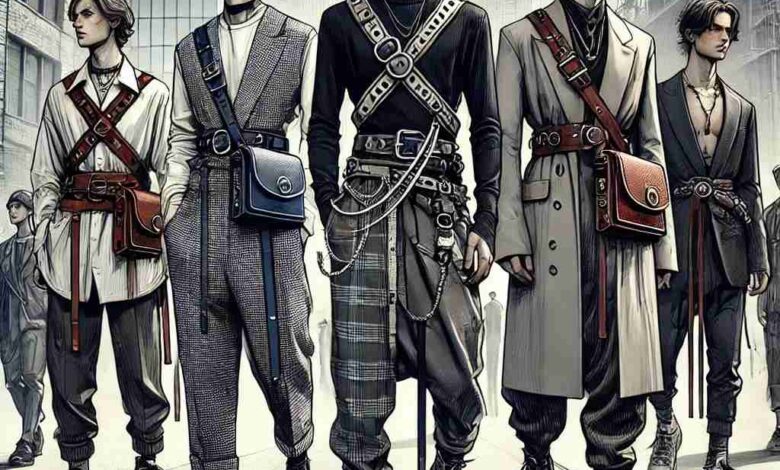How Old is the Baldric Fashion Trend?

The baldric, a belt worn over one shoulder to carry items such as swords, drums, or bugles, is a piece of fashion and utility that has been around for thousands of years. Its origin is ancient, dating back to Roman and even earlier times, where it was primarily used in military contexts. This article dives into the history of the baldric, examining its functional roots and eventual transformation into a ceremonial and symbolic item in modern times. Despite its practical use in history, the baldric has managed to retain its relevance in fashion today.
The Early Beginnings of the Baldric
The baldric dates back to one of the earliest uses in ancient Rome, where soldiers would wear it to carry their swords or any other relevant tool necessary when on duty in the military. As designed, a soldier would easily access the weapon besides feeling less weight since it spread over the shoulder and not around the waist. This, therefore, ensured that one’s arms were free for action, thereby increasing the movement efficiency of the soldier while in battle. In Roman times, the balteus was a variation of the baldric, serving the same purpose but sometimes bearing precious metals and stones to show off the wearer’s status.
Historical evidence reflects that the baldrics had been a part of the formal dress for the high-ranking officers and not purely military adjuncts. There are quite a few examples of them in the ancient Roman tombstone depictions. This gives us an understanding that these had been much more popular during that period. With time, the style and fashion of baldrics kept on changing, and there had been many cultures taking them up one by one and adding each civilization’s hallmark to the design.
The Baldric in the Middle Ages
During the medieval period, the bldric continued to retain its place in armies and among knights. It then became a sign of honor and rank during this period. The knights would be seen wearing very elaborately adorned baldrics or those which are marked with family crests or other emblems of nobility. Functionality was still key because it allowed the knight to carry his sword or shield and keep it at a position of quick access in battle.
Significantly, it is in medieval literature that the cultural and symbolic importance of the baldric has figured. A famous reference is in Sir Gawain and the Green Knight, where Gawain wears a baldric-like green sash signifying his journey and the lessons learned through his trials. This is how not only practical but also deeper symbolic meaning was delivered by the baldric.
The Renaissance and Ceremonial Role of the Baldric
During the Renaissance, the baldric started taking on roles that were more ceremonial. It was not only confined to battlefields but became a part of the uniform for processions, rituals, and all the rest of formal occasions. For example, even nowadays, many military and paramilitary groups incorporate the baldric into their uniform. The Knights of Columbus use the baldric to carry ceremonial swords as part of their uniform.
By now, baldrics have become very ornate with precious metals and complex designs that go far beyond the plain leather straps of the Roman soldier. These ceremonial baldrics, then, were a mark of honor and prestige for both military and religious figures.
The Baldric in Popular Culture
It is for this reason that has not only gone down in history but also into literature and pop culture. The baldric can be found in many stories, such as in The Three Musketeers, where it serves as a holder of their swords, and The Lord of the Rings, worn by Boromir, one of the central characters, to hold a great horn.
Even in science fiction epics, like Star Trek, the Klingon character Worf is always shown wearing a baldric, demonstrating his command.
The presence of the baldric in these stories shows its cultural value. In other words, it is regarded not simply as an object of utility but as a symbol of power, tradition, and heroism associated with historical and fictional narratives.
The Baldric in Modern Times
The baldric now serves a purely ceremonial function in modern times, used with marching bands, military bands, and parades. As a case in point, drum majors in marching bands usually wear baldrics for the carrying of batons, whereas some regiments in the military continue to use them as part of their formal wear. Outside of formal settings, the baldric has found a place in fashion as well.
Although the baldric is no longer commonly worn in the modern era as it was in ancient and medieval times, periodic designer lines take inspiration from the idea, and steampunk and other medieval-fashion adherents occasionally wear a version of the item. Designers often turn to historical clothing concepts as sources of inspiration, and for utilitarian items that are fashion statements themselves, the design of the baldric can serve the inspiration that’s required.
The Bottom Line
How old is the baldric fashion trend, then? In one word, millennial, originating in the ancient military practices—really a very long way. Practical applications in battle soon gave way to symbolic importance in ceremonial contexts; thus, the baldric has had a toehold in history since its beginnings. To this day, though its usage has changed from a necessary accessory to one of fashion and ceremony, it still symbolizes strength, honor, and heritage. Worn by knights in the Middle Ages, Roman soldiers, and modern-day drum majors alike, the baldric remains a distinctive accessory that combines function with tradition.





